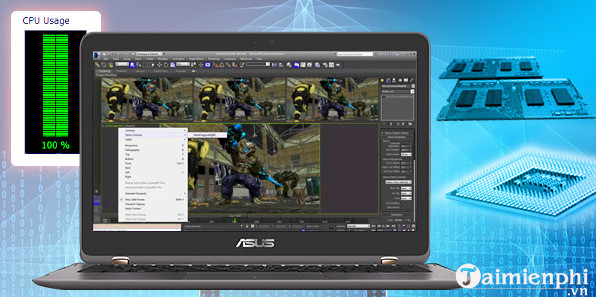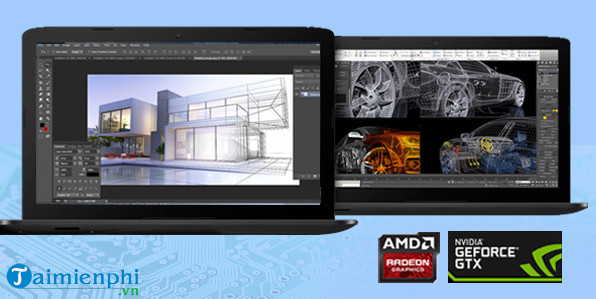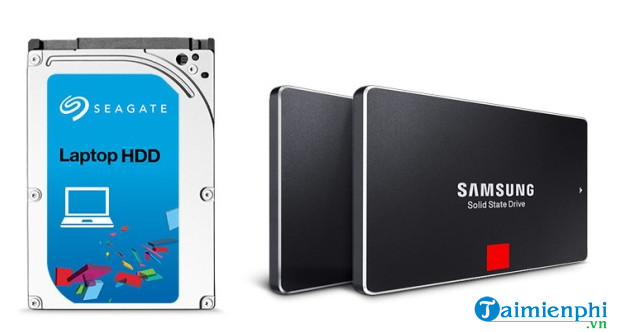How to choose a laptop for graphic designers and technicians
Graphic designers and technicians often have to install and use quite heavy applications, such as Photoshop or 3d Studio Max. If you choose to buy low-configuration laptops, it will definitely cause a series of problems. Continue reading TipsMake's article below to learn how to choose a laptop for graphic designers and technicians .
1. High-end CPU and large RAM
Graphic designers and technicians often have to work on specialized graphic software and applications such as CAD or Photoshop, . . The common characteristic of these applications is that they are very heavy and take up a lot of system resources.

Ideally, you should choose to buy laptops equipped with powerful CPUs , from Core i5 or higher . If choosing a laptop using AMD processors, the A8 or A10 series are the ideal choice. 8GB RAM is enough, but if possible, you can choose to buy laptops equipped with larger RAM memory.
2. Graphics card
If you mainly design and render 2D, just choosing a "mid-range" graphics card such as NVIDIA GeForce GTX1050 or AMD's Radeon R7 , . is enough.

But if 3D design requires choosing a higher-end graphics card. NVIDIA's latest GeForce 10 series of GPUs including the GTX 1060, GTX 1070 or GTX 1080 are ideal choices.
3. Screen resolution
There is a general rule that the higher the resolution, the more suitable it is for designers. Most laptop screens have a resolution of 1366 x 768. However, for people specializing in graphic design and engineering, TipsMake recommends that you choose to buy a laptop with a resolution of 1600 x 900 or 1920 x 1080 . Screen size 15 inches or more, the larger the screen size the better.
4. Hard drives
Laptops are usually equipped with 2 types of hard drives: HDD hard drives and SSD hard drives. HDD hard drives are affordable but operate slower than SSDs.

If you are working with large projects or 3D projects,. you should consider choosing a large capacity hard drive. TipsMake recommends that you choose a laptop with a 1TB hard drive, enough to install all design software and store completed projects. In addition, you should choose to use an SSD hard drive to ensure faster rendering speed and loading of projects.
The above article TipsMake has just guided you how to choose a laptop for graphic designers and technicians. In addition, if you have any questions or concerns such as How to choose to buy a gaming laptop , readers can leave their comments in the comments section below the article.
You should read it
- Do you need a laptop with a 'stone pot'?
- Can you guess the smartphone based on the following parameters?
- How to choose laptop CPU that meets the needs (part 2)
- Shop for a laptop with a tight budget
- Notes when choosing to buy a laptop
- Principles for designing iOS apps
- New design for HP laptop
- Instructions for choosing laptop configuration
May be interested
- How to choose laptop CPU that meets the needs (part 2)
 referring to the cpu, we all know it is the brain, which is the central controller of a computer. so how to choose the right cpu for the computer?
referring to the cpu, we all know it is the brain, which is the central controller of a computer. so how to choose the right cpu for the computer? - Top laptop for graphic design today
 unlike those who want to use laptops for entertainment, web surfing, those who want graphic design require other criteria in a laptop such as large screen and sharpness, reproducibility accurate color; processor chip and graphics card strong ...
unlike those who want to use laptops for entertainment, web surfing, those who want graphic design require other criteria in a laptop such as large screen and sharpness, reproducibility accurate color; processor chip and graphics card strong ... - What is AI file? How to open AI files without Adobe Illustrator
 graphic designers often use vector-based images. they are used for drawings and especially logos and icons. adobe illustrator is the leading graphic design package, so native (ai) files are used as the standard format.
graphic designers often use vector-based images. they are used for drawings and especially logos and icons. adobe illustrator is the leading graphic design package, so native (ai) files are used as the standard format. - Shop for a laptop with a tight budget
 you can absolutely buy a laptop that fits your needs and is especially affordable if you follow the following selection criteria.
you can absolutely buy a laptop that fits your needs and is especially affordable if you follow the following selection criteria. - Top 3 software to get color codes quickly and professionally
 for those of you who are designers or graphic designers, getting color coding is extremely important. if you want to get color code from anywhere on your computer screen quickly and compactly, please refer to 3 color-collecting tools that thut
for those of you who are designers or graphic designers, getting color coding is extremely important. if you want to get color code from anywhere on your computer screen quickly and compactly, please refer to 3 color-collecting tools that thut - How to Use Adobe After Effects
 adobe after effects is a software program that allows its users to create animation and other special effects for graphic-related projects. graphic designers use it to provide their projects with layer-based animation. after effects is...
adobe after effects is a software program that allows its users to create animation and other special effects for graphic-related projects. graphic designers use it to provide their projects with layer-based animation. after effects is... - The best Photoshop alternatives
 adobe photoshop is one of the major software for graphic designers. beginners using adobe photoshop software will have many difficulties getting used to and using it.
adobe photoshop is one of the major software for graphic designers. beginners using adobe photoshop software will have many difficulties getting used to and using it. - Notes when choosing to buy a laptop
 the decision to buy a laptop means you have to spend a significant amount of money. it will not be redundant when you consider to have the most suitable choice ...
the decision to buy a laptop means you have to spend a significant amount of money. it will not be redundant when you consider to have the most suitable choice ... - The best free Photoshop replacement software
 adobe photoshop is one of the great software for graphic designers. beginners using adobe photoshop software will find it very difficult to get used to and use it.
adobe photoshop is one of the great software for graphic designers. beginners using adobe photoshop software will find it very difficult to get used to and use it. - Instructions for choosing laptop configuration
 when buying a laptop, you not only need to pay attention to the product line but also consider the configuration options in that product line. most laptops now offer a variety of configuration options, giving users the choice of processor, ram, storage, screen or battery capacity.
when buying a laptop, you not only need to pay attention to the product line but also consider the configuration options in that product line. most laptops now offer a variety of configuration options, giving users the choice of processor, ram, storage, screen or battery capacity.










 What is Bitcoin? Is it possible to earn Bitcoin yourself?
What is Bitcoin? Is it possible to earn Bitcoin yourself? What is Blockchain technology? Why use Blockchain in Bitcoin mining
What is Blockchain technology? Why use Blockchain in Bitcoin mining What is source code? Learn about Source Code
What is source code? Learn about Source Code How to Test PING on computer
How to Test PING on computer How to use Code Blocks to write C, C++ programs
How to use Code Blocks to write C, C++ programs What is AWS? What is AWS Certification used for?
What is AWS? What is AWS Certification used for?